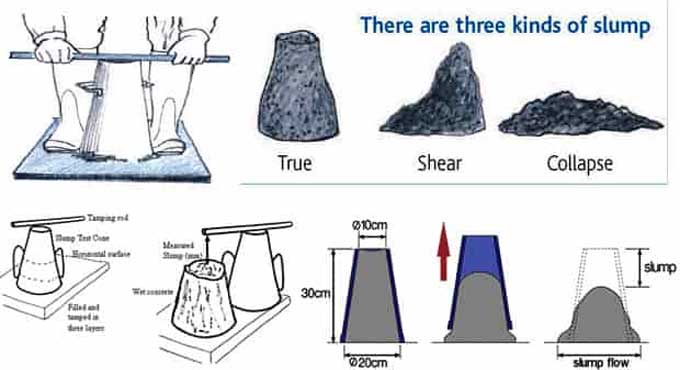
Workflow & Types of Concrete Slump Tests
A concrete's workability can describe how easily it can mix, transport, and place into a position within a homogeneous state. Water content, aggregate quality & fine material percentage are factors affecting the workability of a concrete mix. Many studies have been conducted on measuring the workability of concrete with different parameters. Later, some tests find are very close to assessing workability.
Reasons of Performing Slump Test
Concrete is tested for workability by performing a slump test. It is important to have strong concrete that is workable. Since Slump tests are easy to perform, you can generally conduct them on-site or in a laboratory. Concrete's workability can assess quickly with this test. The Slump Test stands out from the rest of the tests.
Slump Test
This method is quite simple. Concrete that is too wet or too dry will not be suitable for the method. It is a control test that can indicate whether concrete is uniform from batch to batch. The mix will have the same water content and water-to-cement ratio over multiple batches. The aggregate grading is within acceptable limits in repeated batches.
Apparatus
A frustum-shaped plastic mold, a tamping rod with bullet end, and a tape measure can measure Slump. The Slump places with a metal sheet and concrete pour into the Slump with a trowel.
Frustum Cone
The diameters of the highest and lowest points of the Cone of Frustum are different.
Tamping Rod
On one side of this rod, there is a bullet end with a diameter of 16mm. 0.6m is the maximum height for the tamping rod.
Workflow
Cleaning does not mean removing the old concrete and moisture from the Frustum cone's inner surface. The Mould may also position on any smooth surface, such as the metallic steel plate.
Four layers of concrete of approximately 1/4th height each must pour into the cone. A tamping rod tamps each layer 25 times, evenly distributing the strokes throughout the cross-section.
The concrete in the fourth layer struck off using a trowel. Raising the mold slowly and carefully, it immediately removes from the concrete in a vertical direction.
Concrete can subside in this way called a Slump. You now have to measure the height of the mold along with the height of the slump in millimeters. A sub-side's height calculates by comparing the mold level to its highest point.
Benefits of Slump test
It is possible to perform the slump test in the laboratory or on the job site. In comparison to other tests, this one requires fewer instruments. Evaluating the results is quick and easy.
Restrictions of Slump test
If the aggregate in concrete is larger than 40mm, a slump test should not conduct. It does not recommend performing this test on very dry concrete or concrete with high stiffness.
Types of Slump test
Shear Slump
The slump is considered a shear slump when half of it slides down. In this case, it shows that the concrete is non cohesive and has segregation characteristics.
Collapse Slump
During a collapse slump, an entire slump crumbles away from the mold without any trace of mold present. A collapse slump occurs when concrete is over-watered in order to make it more workable.
Zeros Slump
Dry and stiff concrete cannot be tested with this test. The mold cannot be removed from very dry and stiff concrete.
True Slump
Slumps in concrete that form the same shape as a mold are those that slump evenly.
To get more details, watch the following video tutorial.
Video Source: Civil Site visit


